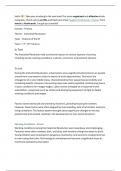Hello ! Take your studying to the next level! For more organized and effective study
materials, check out my profile and flashcard shop Maggie's Flashcards - Payhip. From
notes to flashcards, I've got you covered!
Course : History
Theme : Industrial Revolution
Topic : Impacts of the IR
Years : 17th-18th Century
In Text
The Industrial Revolution had a profound impact on various aspects of society,
including social, working conditions, cultural, economic, and political spheres.
Social
During the Industrial Revolution, urbanization was a significant phenomenon as people
moved from rural areas to cities in search of work opportunities. This led to the
emergence of a new middle class, characterized by their upward social mobility and
increasing wealth. However, the working class was vastly exploited, working long hours
in poor conditions for meager wages. Labor unions emerged as a response to this
exploitation, using tools such as strikes and destroying equipment to fight for better
working conditions and wages.
Factory towns were built and owned by factories, providing housing for workers.
However, these towns were often plagued by overcrowding, lack of amenities, and poor
living conditions. The factory system brought about significant changes in the way
people lived and worked, leading to the development of new social dynamics.
Working Conditions - Social
Working conditions during the Industrial Revolution were hazardous and challenging.
Factories were often crowded, dark, and dirty, with workers toiling from dawn to dusk.
Young children were employed in dangerous machinery, and women's employment led
to men losing their jobs. Technological unemployment became a significant issue as
machines replaced human labor.
, The factory system marked a significant departure from domestic systems where
workers owned the means of production. Employers had minimal relationships with
workers, who were now mere commodities.
Cultural
The Industrial Revolution gave rise to consumerism as people began to purchase goods
and services they previously made themselves or did without. National holidays were
also introduced during this period as a way to give workers a break from their labor.
Economic
The Industrial Revolution established capitalism as the dominant economic system,
characterized by private ownership of the means of production and profit-driven
industry. The shift from an agricultural and handicraft economy to one dominated by
industry and machine manufacturing marked a significant change in the way goods
were produced and distributed.
Political
Labor unions emerged as a response to worker exploitation, providing workers with a
collective voice and bargaining power. Trade unions like IG Metall fought for better
working conditions and wages. Socialists sought to reform or abolish the industrial
system, advocating for worker control over production.
Legal protections for workers were established during this period, including limited
hours for women, eventual end to child labor, health and safety codes, minimum wage
laws, and legalization of unions. Cooperative societies also emerged, where members
shared profits or benefits jointly.
The Communist Manifesto written by Karl Marx and Friedrich Engels called for the
overthrow of capitalism and establishment of a classless society. The Chartists
campaigned for universal suffrage, demanding that politicians listen to working-class
complaints.




